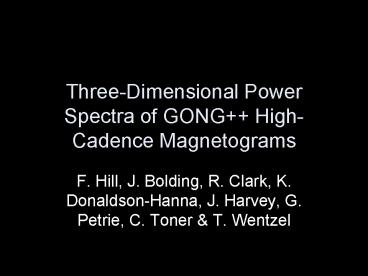Three-Dimensional Power Spectra of GONG High-Cadence Magnetograms - PowerPoint PPT Presentation
1 / 13
Title:
Three-Dimensional Power Spectra of GONG High-Cadence Magnetograms
Description:
Evershed flow from spot. Flickering field in spot (probably seeing and ... Spot not circular. 5-min oscillations detectable in quiet region but anisotropic! ... – PowerPoint PPT presentation
Number of Views:26
Avg rating:3.0/5.0
Title: Three-Dimensional Power Spectra of GONG High-Cadence Magnetograms
1
Three-Dimensional Power Spectra of GONG
High-Cadence Magnetograms
- F. Hill, J. Bolding, R. Clark, K.
Donaldson-Hanna, J. Harvey, G. Petrie, C. Toner
T. Wentzel
2
GONG Magnetograms
- Obtain one per minute, 24-7, average duty cycle
of 0.87 - Noise level 3G per pixel per minute
- Recent installation of new modulators reduced
zero-point background to 0.1 G - Hourly synoptic products
- Here look at 1-min merged magnetograms
3
Merging
- Obtain as many as four simultaneous images for a
given minute need to merge - Tested histogram equating method (H. Jones)
- Take two magnetograms
- Form cumulative histogram of field on disk
- Find linear transformation to produce nearly
identical histograms - Apply to images
- Found that this does not work when considering a
time series of images with variable seeing - Currently using a very simple scheme
- Register and circularize simultaneous images
- Simply average
4
The movie
- Sequence of 3200 images/minutes starting on July
1, 2006 at 0 UT - Fill factor of 0.95 (148 missing images)
- Missing images are not interpolated across,
simply skipped - 32 square patch tracked and remapped using GONG
ring pipeline - Patch tracked symmetrically across central
meridian - Tracking at photospheric rate, not magnetic rate,
so some drift
5
One frame
Contains quiet area, sunspot, and
network/decaying active region
6
The movie
- Highly time compressed 53 hours in about 10 sec
(20,0001 compression) - Things to look for
- Evershed flow from spot
- Flickering field in spot (probably seeing and
line blending in strong fields)
7
3-D Power Spectra
- Analyze field in three 16 areas
- Spot region (lower right)
- Network/decaying region (lower left)
- Quiet region (upper left)
- Compute 3-D FFT, then power
8
Slices at constant frequency of 31.25 µHz (Period
of 8.9 hr)
Power offset due to drift from tracking rate.
Once corrected, should be able to measure outflow
velocities.
9
Slices at constant frequency of 3333.33 µHz
(5-min band)
10
Closer look at anisotropic oscillations
Use entire 32 area for analysis mixes
different field characteristics, increases k
resolution.
2917 µHz
3125 µHz
3333 µHz
3542 µHz
3750 µHz
11
Causes?
- Instrumental
- Velocity undoubtedly leaks into B
- Polarization measurements taken at different
times? - Spatial offset of polarization measurements?
- Processing
- No problems in spectrum computation
- Merging?
- Interpolation?
- Solar
- Magnetic field selects a propagation direction?
- ??
12
Conclusions
- GONG continual high-cadence merged magnetograms
available shortly. - Good for rapid changes (e.g. flares, flows,
oscillations). - 3-D power spectra useful for magnetic field
studies. - Strange anisotropic behavior of oscillations?
13
Postcsript
- While at Melbourne, R. Bogart managed to process
some MDI 1-min magnetograms - He found similar results incomplete rings in a
quiet area - Need to get larger sample in many different
situations of activity to understand

